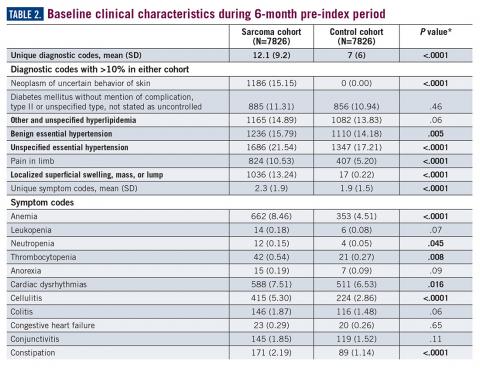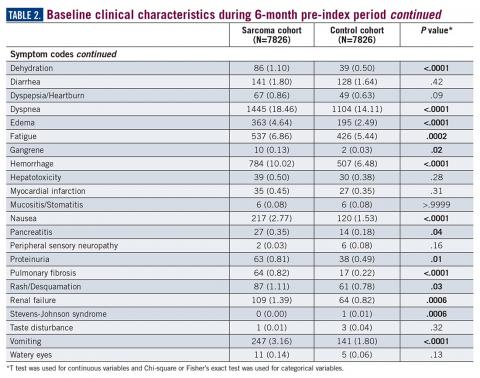All ICD-9 diagnostic and procedure codes present in the matched 6-month time period pre-index diagnosis were compared to explore factors that may be more likely to be present in the sarcoma cohort compared to matched controls. Univariate analysis was conducted for each prediagnosis variable. Analyses were conducted using T test for continuous variables, and Chi-square or Fisher’s exact test was used for categorical variables.
Number of physician visits, inpatient hospital stays, surgical procedures, and emergency room visits were compared between those in the sarcoma cohort and matched controls during the matched 6-month pre-index period. The post-index diagnosis employment status was also compared between groups using the HPM database. Comparisons between the sarcoma cohort and control cohort were made among the actively employed patients at baseline related to the proportion of patients who continued active employment, the proportion who permanently discontinued work, and the proportion who initially discontinued work and then returned to work at a later time. No adjustments were made for multiple comparisons.
Results
A total of 7826 controls were each matched to patients in the sarcoma cohort. The baseline characteristics of the study cohorts are provided in Table 1.
Patients with a suspected sarcoma had a mean age of 58 and were relatively balanced between male (52%) and female (48%) patients. All matched clinical and demographic variables were equivalent between groups as demonstrated in Table 1, as would be expected. The average duration of follow-up in the database was longer for the control cohort (1517.6 days, standard deviation [SD]=923.8) than for patients suspected of having sarcoma (924.5 days, SD=811.5) (P<.0001).During the 6-month period before the sarcoma diagnosis (prediagnosis period), patients had significantly greater frequency of diagnoses identified than controls for uncertain neoplasms, limb pain, and hypertension (all P<.001, Table 2).
Both groups had type 2 diabetes rates higher than 10%. The symptoms patients were experiencing during the 6-month matched prediagnosis period were notable, as presented in Table 2. Most ICD codes identified in the cohorts during this period were significantly higher among those later suspected of having sarcoma, including anemia, neutropenia, thrombocytopenia, cardiac dysrhythmia, cellulitis, constipation, dehydration, diarrhea, dyspnea, edema, fatigue, gangrene, hemorrhage, nausea, pancreatitis, proteinuria, pulmonary fibrosis, rash, renal failure, vomiting, and watery eyes (all statistically significant at P<.05).Similarly, the majority of health care resource utilization factors evaluated showed statistically higher health care use among patients later suspected of having sarcoma than matched controls (Table 3).
Patients later suspected of having sarcoma were more likely to have surgical procedures, including an excision, resection, biopsy, or diagnostic procedure (all P<.0001). Blood tests were also more likely to have been performed among those diagnosed with sarcoma (41.5% vs 29.2%, P<.0001). Hospitalizations occurred in 15.6% of those diagnosed with sarcoma versus 7.7% among controls (P<.0001). Emergency room visits and physician clinic visits were also statistically significant, but the absolute rates were more modest (18.7% vs 14.6% and 94.3% vs 91.3%, respectively).




